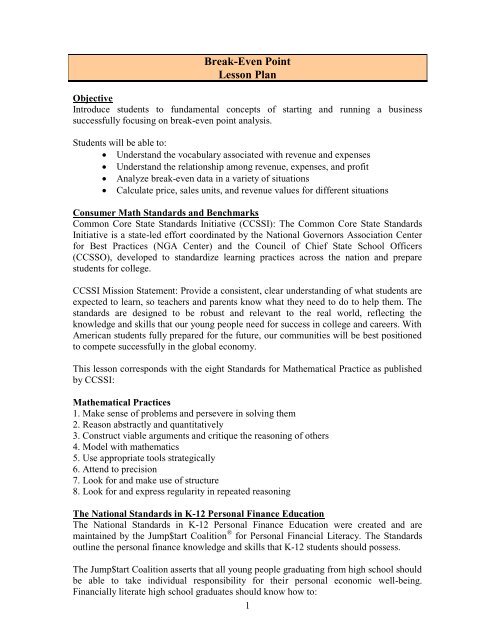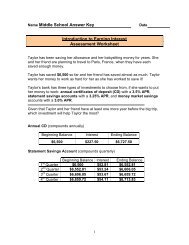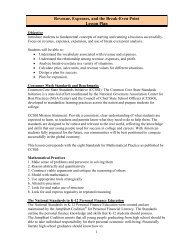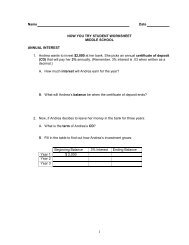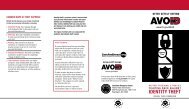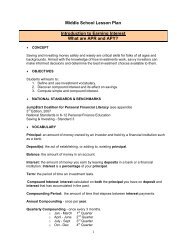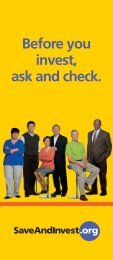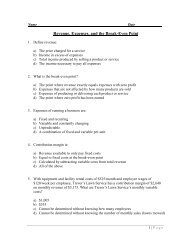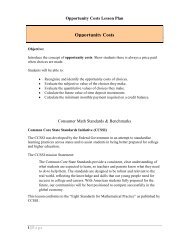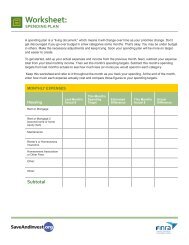Break-Even Point Lesson Plan - SaveAndInvest.org
Break-Even Point Lesson Plan - SaveAndInvest.org
Break-Even Point Lesson Plan - SaveAndInvest.org
- No tags were found...
You also want an ePaper? Increase the reach of your titles
YUMPU automatically turns print PDFs into web optimized ePapers that Google loves.
<strong>Break</strong>-<strong>Even</strong> <strong>Point</strong><strong>Lesson</strong> <strong>Plan</strong>ObjectiveIntroduce students to fundamental concepts of starting and running a businesssuccessfully focusing on break-even point analysis.Students will be able to: Understand the vocabulary associated with revenue and expenses Understand the relationship among revenue, expenses, and profit Analyze break-even data in a variety of situations Calculate price, sales units, and revenue values for different situationsConsumer Math Standards and BenchmarksCommon Core State Standards Initiative (CCSSI): The Common Core State StandardsInitiative is a state-led effort coordinated by the National Governors Association Centerfor Best Practices (NGA Center) and the Council of Chief State School Officers(CCSSO), developed to standardize learning practices across the nation and preparestudents for college.CCSSI Mission Statement: Provide a consistent, clear understanding of what students areexpected to learn, so teachers and parents know what they need to do to help them. Thestandards are designed to be robust and relevant to the real world, reflecting theknowledge and skills that our young people need for success in college and careers. WithAmerican students fully prepared for the future, our communities will be best positionedto compete successfully in the global economy.This lesson corresponds with the eight Standards for Mathematical Practice as publishedby CCSSI:Mathematical Practices1. Make sense of problems and persevere in solving them2. Reason abstractly and quantitatively3. Construct viable arguments and critique the reasoning of others4. Model with mathematics5. Use appropriate tools strategically6. Attend to precision7. Look for and make use of structure8. Look for and express regularity in repeated reasoningThe National Standards in K-12 Personal Finance EducationThe National Standards in K-12 Personal Finance Education were created and aremaintained by the Jump$tart Coalition ® for Personal Financial Literacy. The Standardsoutline the personal finance knowledge and skills that K-12 students should possess.The Jump$tart Coalition asserts that all young people graduating from high school shouldbe able to take individual responsibility for their personal economic well-being.Financially literate high school graduates should know how to:1
X(P – V) = FCx = FC(P – V)Comprehension CheckExercise for students to calculate:If I sell a product for $79.99 that costs me $11.99 per unit to produce and my fixed costsamount to $27,336.00, how many units must I sell to break-even?FC $27,336 27,336x 402( P V) ($79.99 $11.99)68<strong>Break</strong>-even sales dollars (pages three and four of student document): The amount ofrevenue needed to reach the break-even point.Once the break-even sales units figure is calculated then the break-even sales dollars canbe determined:<strong>Break</strong>-even sales dollars = Price per unit X break-even sales units<strong>Break</strong>-even sales dollars = P x FC(P – V)Work through the example of break-even sales dollars calculation (page five of studentdocument)Class DiscussionSuggested discussion points to pose with students. Expected responses are also included,but student perspectives may provide interesting conversation.Think about the formula: Revenue = Expenses + ProfitName three ways to increase profit from a business.Expected responses: Increase Revenueo Increase revenue by raising prices. Expenses will remain constantresulting in an increase in profit.o Increase revenue by selling more units. The contribution margin will risefurther than variable expenses resulting in an increase in profit. Reduce Expenseso Reducing fixed costs, variable costs, or both will result in an increase inprofit to keep the right side of the equation in balance with revenue. All of the above4
CM = Revenue – Variable Cost = $10.00 - $5.56 = $4.44$4.44 per pizzaCalculate the break-even sales units and break-even sales dollar figures<strong>Break</strong><strong>Even</strong>SalesUnits = x =FC(P -V) = $5,650($10.00 -$5.56) = 5650 =1,272.5 =1,273pizzas4.441,273 pizzas<strong>Break</strong>-even sales dollars = Price per unit X break-even sales units Sales dollars = ($10.00) x (1,273 pizzas) = $12,730.00Assessment/EvaluationFollowing is the break-even point assessment to check students’ comprehension.1. Blue Corp shows monthly fixed costs of $1,797 and per unit cost of $9.28 whileselling 411 units in a single month.What is the minimum price Blue Corp must sell each unit for to break-even?X = FC 411 = 1797 411(P – 9.28) = 1797 P = 1797 + 9.28(P-V) (P - 9.28) 411P = $13.652. A start-up company has the following expenses:Rent = $1,100Utilities = $265Material and assembly = $12.65/unitMonthly labor = $625If their product sells for $29.99/unit, how many units must they sell to break-even?FC = 1100 rent P = 29.99 V = 12.65265 utilities X = 1990 = 1990 = 114.76625 labor (29.99 – 12.65) 17.341990X = 115 units3. I sell a product for $24.75 and fill orders averaging 37 units per day. My cost toproduce and assemble each item is $3.11. If I am open for business five days perweek, what is my contribution margin per unit?CM = Revenue – Variable CostCM = 24.75(1) – 3.11(1)6
CM= $21.64/unit4. What is the break-even sales dollars figure for an operation that sells 615 products at$17.50, when each item costs $7.05 to produce, and the fixed costs for the operationare $3,700/month?X = FC = 3700 = 370 = 354 (<strong>Break</strong>-even sales units)(P-V) (17.50 – 7.05) 10.45<strong>Break</strong>-even sales dollars = 354 x $17.50 = $6,1955. A company sells 900 units/month at $49.99 each, with an $18.12 per unit cost, and$2,175 monthly fixed cost. Is this company making a profit?Px = FC + Vx + Profit(49.99) x 900 = 2175 + (18.12) 900 = 2175 + 16308 + Profit44991 = 18483 + ProfitYes, their profit = $26,5086. Tandem Trucking spends $11,455 per month to run their business. They make anaverage of 420 deliveries per month at a fee of $55.00 per delivery. Rounded to thenearest percent, what is Tandem’s monthly return on their $11,455 investment?FC = 11,455 x = 420 P = $5555(420) = 11455 + Profit 23100 = 11455 + Profit Profit = $11,645Return = Profit = 11,645 = 1.0166 = 1.02Investment 11455Return = 102 percent7. I sell a product for $35.00. My fixed costs for the week are $194.00 and it costs me$2.10 per product to produce. If I sell only six products this week, how am I doing?35(6) = 194 + 2.10(6) + Profit210 = 194 + 12.60 + Profit210 = 206.60 + Profit$3.40 = Profit (Broke-even with a slight profit of $3.40)8. Zyleron Corp shows monthly fixed costs of $37,210 and per unit costs of $34.79while selling 275 units in a single month. What is the minimum price Zyleron Corpmust sell each unit for to break-even?Px = FC + Vx P(275) = 37,210 + 34.79(275) = 275(P) = 46,777.25P = 46,777.25275P = $170.017
9. A start-up company has the following expenses:Rent = $875Utilities = $115Material and assembly = $4.75/unitMonthly labor = $480If their product sells for $18.99/unit, how many units must they sell to break-even?FC = rent + utilities + labor = 875 + 115 + 480 = $1,470VC = $4.75P = $18.99X = FC = 1470 = 1470 = 103.23(P-V) (18.99-4.75) 14.24X = 103 units10. I sell a product for $21.50 and fill orders averaging 19 units per day. My cost toproduce and assemble each item is $8.47. If I am open for business five days perweek, what is my contribution margin each week?P = 21.50 x = 19 x 5 = 95/week VC = 8.47Contribution Margin = Revenue – Variable CostCM = (21.50)(95) – 8.47(95)CM = 2042.50 – 804.65CM= $1,237.85/weekAnswer KeyQuestion Answer1 $13.652 115 units3 $21.64/unit4 $6,1955 Yes, they are making a profit of $26,5086 102%7 Broke-even with a slight profit of $3.40.8 $170.019 103 units10 $1,237.85/week8


